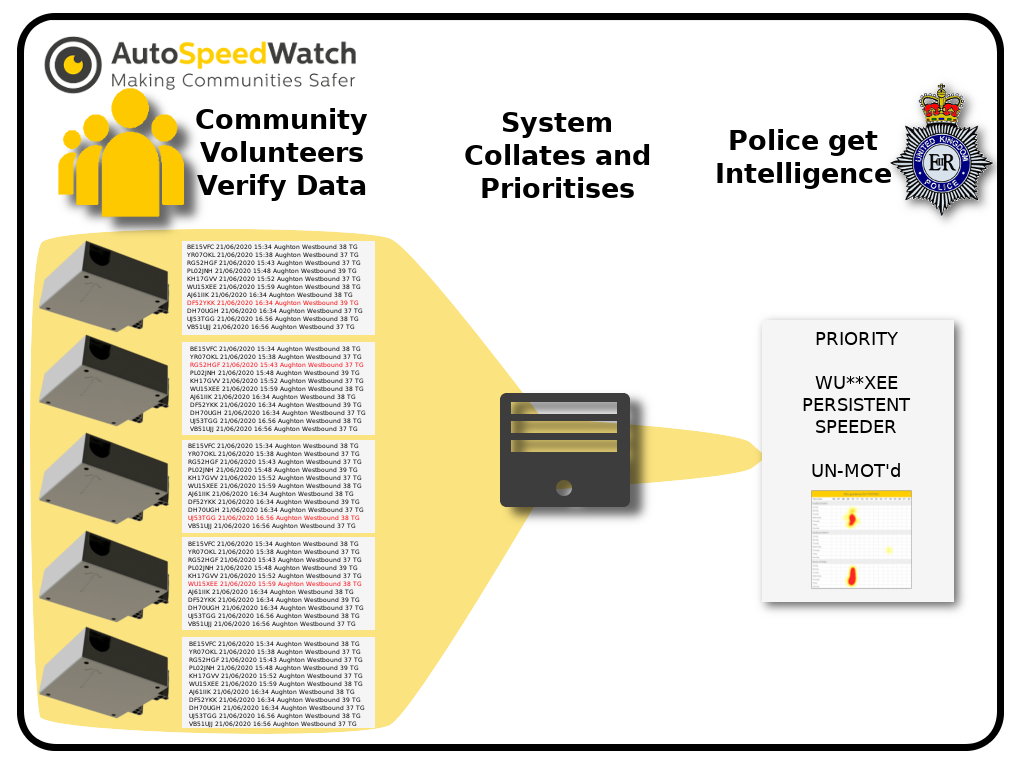Police
Police get precise information with less effort
You don't need the police to use AutoSpeedWatch as a deterrent, but their action makes the system more powerful. The system very obviously shows which vehicles behaviourally speed and therefore cause the greatest risks. The Police can choose to receive:
- generalised location intelligence, or
- specific vehicle AND general location intelligence
depending on what they want to achieve. More detail is available on the Police Intelligence page.
We've found some police hear "AutoSpeedWatch" and assume it's robots flooding them with data. Absolutely NOT. It's the opposite (see right). It gives the police one piece of high level intelligence, rather than loads of individual log data. Typically just 15 vehicles will be the cause of more than 1000 offences in a 6 month period. This system crunches data to show which vehicles speed, and where and when do so. It is fully legal, driver educational, improves safety, and its operation is compliant with the BSCC Codes of Practice.
Which UK forces are already using AutoSpeedWatch?
With widespread deployment of units, we understand that the following forces are already receiving AutoSpeedWatch intelligence to assist with road safety policing and other crime areas:
|
|
Other forces may also be supporting their communities' use of AutoSpeedWatch..... let us know and we'll update this list.
Common police queries
"It'll mean sending loads of warning letters"
Not so, but it's a common misunderstanding. The entire point is that it saves Police effort and cost. It identifies and collates the worst speeders automatically, allowing police to target resources to where it has the biggest safety impact. They can prioritise and send as few, or as many, letters as resources allow knowing they'll be far more targeted and effective (examples indicate 80 times more efficient over a 6 month period!). The intelligence AutoSpeedWatch provides means their limited resources have a bigger safety impact, and better public support.
"We can't because of GDPR/ICO/BSCC"
AutoSpeedWatch is fully compliant with Home Office camera guidelines and meets UK law, and is actually far less intrusive than other existing systems. It provides the same community-verified information as traditional speedwatch but organised to be more useful. It does not collect or store personal information, and is not constrained by GDPR, but nonetheless manages publicly visible VRN data as if potentially sensitive. Owner and keeper information always remain within the police domain. The Biometrics & Surveillance Camera Commissioner (BSCC, previously SCC) has confirmed the legitimacy of such systems. Autospeedwatch Limited has even been previously assessed and certified as compliant with the BSCC Codes of Practice (scheme no longer available). See our section on UK law for details. For those forces that do not want VRN data we provide an option to see only general location intelligence and not specific vehicle information. NASPLE regulations do not apply to Speed Cameras.
"Policy says no fixed enforcement camera"
It's not an enforcement camera, it's a proven system that modifies driver behaviours. Where yellow enforcement cameras have been withdrawn, it will likely be due to the 2008 restructuring of funding support from the Department for Transport, or because of public sentiment against the police for 'profiteering' from speeding. The system cannot be used to issue fines but instead guides better policing. The public tend to support AutoSpeedWatch because it targets the worst driving and reduces speeds generally.
"It needs to be calibrated"
AutoSpeedWatch is not used to issue penalties, but it needs to be accurate and reliable sufficient to provide excellent police intelligence. Only Home Office type approved equipment can be used as evidence for issuing penalties and that equipment is requires annual calibration. The radar equipment used by Community Speedwatch groups are not required to meet the Home Office type approval standards. Instead mass-market radar devices typically used to provide information for guidance. AutoSpeedWatch has been well tested and shown to accurately report speeds, and the use of persistent offenders makes false accusation far rarer than traditional speedwatch.
"We need the visible deterrence of yellow jackets"
The argument of risking people at the roadside makes no sense at all. It's not the yellow jackets that changes driver behaviour, it's the prospect of being caught. This is why motorway average speed cameras are so effective. By using Signs and the optional Consipicuity Kit then AutoSpeedWatch is very visible, and the risk of being caught is constantly present; an independent assessment demonstrated AutoSpeedWatch reducing speeding by half, even before police enforcement. If the expectation of being caught is constant then the impact will be longer lasting than ad-hoc traditional speedwatch. Evidence shows massive improvements, for example reducing speed above 40mph in a 30 zone from 42% to 16%. It simply works.
Speeding above 45mph in a 30 zone reduced from 65% to 14%.
Average Speed Zone: average speeds reduced from 36mph to 28mph in 30mph zone.
Just 15 vehicles caused over 1809 offences in just 6 months
Besides, AutoSpeedWatch does not prevent traditional speedwatch sessions; it adds to them. Traditional speedwatch has been around for two decades now. We still have speeding. Isn't it time to be more effective?
